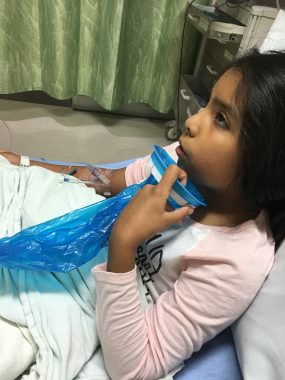5 Years of Living, Learning, and Advocating for Pediatric NMOSD Patients
Columnist Candice Galvan's daughter was diagnosed at 9. Now she's starting high school

Five years ago, Aug. 28, 2017, began like any other day. I had taken the day off work to run errands, and I got up early to help my youngest daughter, Bella, get ready for school. She had just started fourth grade at a new school and had a long day of learning ahead.
Shortly after Bella woke up, she complained that she wasn’t feeling well. She didn’t have a fever, and I thought that maybe her nerves were getting the best of her, so I let her stay home for the day.
As our day progressed and Bella patiently waited for me to finish my errands, I noticed that she truly wasn’t feeling well. She was tired, lethargic, and nauseous — all out of character for our very energetic 9-year-old. Bella’s condition continued to deteriorate over the next few days and involved several doctors and trips to the emergency room.
Four days after falling ill, Bella was diagnosed with pancreatitis, which is relatively rare for a child. The tests came back late in the evening, and we were transferred by ambulance to Children’s Hospital of Colorado. It was the day before my birthday, and all I remember wishing for was for Bella to feel better and receive the care she needed to recover. The next week or so felt like a blur of highs and lows.
Bella’s condition became so grave at one point that she was placed in a medically induced coma to help with her breathing, swallowing, retching, and constant hiccups. It wasn’t until mid-September when we learned that Bella had tested positive for the antibodies that target the water channel protein aquaporin-4. She was officially diagnosed with neuromyelitis optica spectrum disorder, or NMOSD.

Candice Galvan
Bella receives treatment in a hospital emergency room on Sept. 1, 2017. (Photo by Candice Galvan)
On our own
I’ll never forget the relief my husband and I felt when we received Bella’s diagnosis. I couldn’t wait for the doctors to provide me with brochures, a plan, and most importantly, a promise that there was a cure for this disease. The relief we felt quickly faded when Bella’s doctors told us that not only is neuromyelitis optica spectrum disorder a rare disease, but it’s even rarer in children.
We were instructed to do our own research about NMOSD by going online and reading more about the disease. As my husband and I stood vigil by Bella’s side, we began that research. We learned that while there is treatment, there is no cure for NMOSD.
The more I read online about NMOSD, the more terrified I became. I had so many questions, but felt like I didn’t have anyone to talk to who could answer them. I wanted to connect with someone who understood what we were going through and could provide us with perspective as a starting point for understanding this new journey of ours. I turned to social media hoping to connect with others who have been diagnosed with NMOSD and those caring for them.
I joined a few social media groups, and through my conversations, I was able to locate a couple foundations: the Guthy-Jackson Charitable Foundation and The Sumaira Foundation. Both are dedicated to researching NMOSD and bringing patients and their caregivers together to provide a community of support.
Finding our community
Once I began telling Bella’s story, several NMOSD warriors reached out to share with me their stories of survival and determination. Hearing everyone’s stories gave me hope. I couldn’t wait to share them with Bella, especially on those days that were full of challenges and pain for my little NMOSD warrior.
I even reached out to Sumaira Ahmed, founder of The Sumaira Foundation, and to our surprise, she wrote back right away. She began sharing Bella’s story through her foundation in the hope that it would lift Bella’s spirits and help with her recovery. Bella and I are extremely thankful for the support and compassion our new lifelong friend Sumaira extended to us during such a challenging time.
As a mom, I promised Bella that no one would forget her or this journey we were on. I vowed to be Bella’s strength when she needed it, because she was mine every day. As a caregiver, it has been my mission to raise my voice, spread awareness about NMOSD, and be a source of comfort and support for patients and caregivers who are new to NMOSD.
Progress
In the last five years, Bella has completed elementary and middle school, and recently started her freshman year of high school. She is an incredible artist, seamstress, dog mama, sister, daughter, and independent 14-year-old with dreams and adventure ahead.
I continue to learn about new NMOSD research, treatments, and other discoveries. I also lead a support group for other NMOSD patients and caregivers that meets twice a month to talk. I have been able to connect with families of the youngest NMOSD patients and others who have been fighting the disease for decades.
I am grateful for the researchers who work hard to find a cure for NMOSD so that no one else has to experience the darkness of the disease.

Candice Galvan
Bella on her first day of high school in August. (Photo by Candice Galvan)
Note: Neuromyelitis News is strictly a news and information website about the disease. It does not provide medical advice, diagnosis, or treatment. This content is not intended to be a substitute for professional medical advice, diagnosis, or treatment. Always seek the advice of your physician or other qualified health providers with any questions you may have regarding a medical condition. Never disregard professional medical advice or delay in seeking it because of something you have read on this website. The opinions expressed in this column are not those of Neuromyelitis News or its parent company, Bionews, and are intended to spark discussion about issues pertaining to neuromyelitis optica spectrum disorder (NMOSD).








Leave a comment
Fill in the required fields to post. Your email address will not be published.